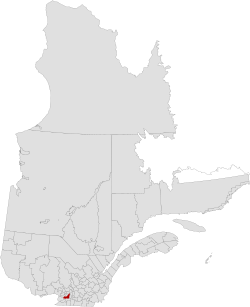|
Urban agglomeration of Montreal
The urban agglomeration of Montreal (French: agglomération de Montréal) is an urban agglomeration in Quebec, Canada. Coextensive with the administrative region of Montreal, it is a territory equivalent to a regional county municipality (TE) and a census division (CD), for both of which its geographical code is 66. Prior to the merger of the municipalities in Region 06 in 2002, the administrative region was co-extensive with the Montreal Urban Community. Located in the southern part of the province, the territory includes several of the islands of the Hochelaga Archipelago in the Saint Lawrence River, including the Island of Montreal, Nuns' Island (Île des Sœurs), Île Bizard, Saint Helen's Island (Île Sainte-Hélène), Île Notre-Dame, Dorval Island (Île Dorval), and several others. Only the first three of these islands are inhabited. The region is the second-smallest in area (498.29 km2 (192.39 sq mi)) and most populous (2,004,265 as of the 2021 Canadian Census)[1] of Quebec's seventeen administrative regions. GovernmentThe administrative region consists of the 2002–2005 territory of the city of Montreal. Following merger of the municipalities of the agglomeration on January 1, 2002, sixteen of its municipalities were reconstituted on January 1, 2006. The urban agglomeration is governed by the Montreal Agglomeration Council (French: Conseil d'agglomération de Montréal), which is composed of:[3][4]
The executive of the council is the Montreal Executive Committee, which can be headed by the Mayor of Montreal or a councillor the mayor appoints.[4] The weighting of votes for the council breaks down to 87% for the City of Montreal, and 13% for the other municipalities of the Island of Montreal.[5] PowersThe agglomeration council is granted responsibility over:[6]
And any other local responsibilities under the Municipal Powers Act. However, the city of Montreal is not obligated to execute these powers, and may delegate powers to local municipalities or other governing bodies.[6] Powers delegated to the Montreal Metropolitan Community (French: Communauté métropolitaine de Montréal, CMM), the regional government of Greater Montreal, by the urban agglomeration include public housing, economic development, and water supply and water treatment.[7] Responsibility for public transit is shared with the agglomeration directly appointing members to the RTM, the regional transportation authority, and indirectly appointing members to the ARTM, the regional public transport planning authority, via the Montreal Metropolitan Community. Subdivisions Cities
Village See alsoReferences
External links
|
||||||||||||||||||||||||||||||||||||||||||
